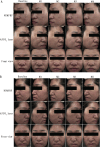Comparison of Non-insulated Microneedle Fractional Radiofrequency and Ablative Fractional Carbon Dioxide Laser for the Treatment of Facial Atrophic Acne Scarring: A Pilot Randomized Split-face Clinical Study
- PMID: 40568948
- PMCID: PMC12228042
- DOI: 10.2340/actadv.v105.43611
Comparison of Non-insulated Microneedle Fractional Radiofrequency and Ablative Fractional Carbon Dioxide Laser for the Treatment of Facial Atrophic Acne Scarring: A Pilot Randomized Split-face Clinical Study
Abstract
A study was undertaken to compare the effectiveness and adverse effects of non-insulated microneedle fractional radiofrequency (NIMFRF) and ablative fractional carbon dioxide (AFCO2) laser on facial atrophic acne scarring in a randomized split-face model. Thirty subjects with facial atrophic acne scarring were enrolled. Each side of the face randomly received 1 session of NIMFRF or AFCO2 laser. Photographs were taken by VISIA Complexion Analysis System at baseline, 1 month, 2 months, and 6 months after treatments. Subjective evaluations included Échelle d'Évaluation Clinique des Cicatrices d'Acné (ECCA) score, global improve-ment, and self-satisfaction. Potential adverse effects were also recorded. Skin melanin index and ery-thema index were measured. NIMFRF and AFCO2 laser show-ed comparable efficacies on atrophic acne scarring (p > 0.05). ECCA scores decreased significantly at each follow-up visit, compared with baseline (p < 0.05). Approximate 95% of subjects achieved "satisfied" or "very satisfied" improvement. Pain was more obvious on the AFCO2 laser side. Significantly increased red area value, melanin index and erythema index levels were seen on the AFCO2 laser side at one month or 2 month, compared with the NIMFRF side (p < 0.05). NIMFRF has milder adverse effects with shorter recovery period than AFCO2 laser. NIMFRF may be preferable for some patients due to its favourable adverse effect profile.
Conflict of interest statement
Figures




Similar articles
-
Interventions for acne scars.Cochrane Database Syst Rev. 2016 Apr 3;4(4):CD011946. doi: 10.1002/14651858.CD011946.pub2. Cochrane Database Syst Rev. 2016. PMID: 27038134 Free PMC article.
-
Atrophic acne scar: a novel 4-step treatment approach using the ultra-pulse fractional CO2 laser.Lasers Med Sci. 2025 Aug 28;40(1):345. doi: 10.1007/s10103-025-04603-8. Lasers Med Sci. 2025. PMID: 40866693
-
Efficacy of Microneedle Fractional Radiofrequency Combined With Topical Insulin for the Treatment of Facial Atrophic Acne Scars: A Split-Face, Double-Blinded, Randomized, Placebo-Controlled Trial.J Cosmet Dermatol. 2025 Feb;24(2):e70033. doi: 10.1111/jocd.70033. J Cosmet Dermatol. 2025. PMID: 39970082 Free PMC article. Clinical Trial.
-
Efficacy of fractional CO2 laser therapy combined with hyaluronic acid dressing for treating facial atrophic acne scars: a systematic review and meta-analysis of randomized controlled trials.Lasers Med Sci. 2023 Sep 19;38(1):214. doi: 10.1007/s10103-023-03879-y. Lasers Med Sci. 2023. PMID: 37723352
-
Comparison of Fractional Micro-Plasma Radiofrequency and Fractional Microneedle Radiofrequency for the Treatment of Atrophic Acne Scars: A Pilot Randomized Split-Face Clinical Study in China.Lasers Surg Med. 2021 Sep;53(7):906-913. doi: 10.1002/lsm.23369. Epub 2020 Dec 16. Lasers Surg Med. 2021. PMID: 33326634 Clinical Trial.
References
Publication types
MeSH terms
LinkOut - more resources
Full Text Sources
Medical

